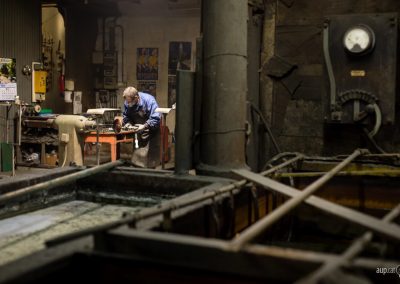P3: Pujada de Sant Martí (Cromats Ensesa)
Third stop
Pujada de Sant Martí (Cromats Ensesa)
Other processes that are carried out at this company are nickel and silver plating. There are also alloys such as bronze or brass. Alloys are mixtures of two or more metals and their purpose is to improve the qualities of the separate metals. Bronze is a mixture of copper and tin, and has many applications, ranging from the manufacture of weapons (Bronze Age) to bells. Brass contains bronze and zinc and is used in musical instruments and decorative pieces, for example.
Did you know?
Originally, the angel on the Cathedral was not an angel, but a figure that represented faith, and wore a blindfold over its eyes. When work on the current Gothic nave began, around the 14th century, the figure was placed at the cathedral’s provisional entrance. Later, in the 18th century, it was placed atop the current Renaissance bell tower. During the Napoleonic sieges, a French bullet decapitated the sculpture.
Not long ago, the figure, which had been damaged by weather over time and by bullets from different eras, was restored. Following popular wisdom, which had identified the sculpture as an angel for many years, it was given a head with open eyes.
Plàstics
Els plàstics són materials orgànics, polimèrics, derivats del petroli. Poden tenir origen natural (com el cautxú) tot i que la majoria són sintètics, obtenint així una gran diversitat de plàstics.
Una de les seves principals propietats és que a l’aplicar-li una força pot canviar la seva forma, recuperant-la quan es deixa d’aplicar. Els plàstics presenten baixa densitat, són bons aïllats elèctrics i tèrmics, i capaços de resistir molts factors químics. A més, poden reciclar-se i n’existeixen de biodegradables.

Niquelats
Els niquelats es fan servir com a electròlits de sulfat de níquel o clorur de níquel.
El níquel és un metall platejat, brillant, conductor de l’electricitat i de la calor, resistent a la corrosió, és dúctil i mal·leable pel que es pot laminar, polir i forjar fàcilment.
Es troba en diversos minerals, en meteorits (aliat amb ferro), i se suposa que el centre de la Terra està format principalment per ferro i níquel. És un metall present en la majoria de les monedes, normalment formant un aliatge amb el coure.

Bronze
El bronze és un aliatge de coure i estany, amb proporcions d’aquest darrer metall que poden anar del 8 al 40 % i que conté petites quantitats d’altres elements. Aquest aliatge s’utilitza des de temps prehistòrics (edat del bronze) perquè és fàcil de preparar i té bones qualitats, com la resistència a la corrosió i la facilitat per ser emmotllat. Antigament es va utilitzar per a la fabricació d’armes, però a mida que es van descobrir millors materials i que es va abaratir la seva fabricació es va utilitzar en la fabricació d’eines, cuirasses, estàtues, recipients, ornamentació, etc.
Una altra de les característiques del bronze n’és la seva bona sonoritat, raó per la qual tradicionalment s’ha emprat en la fabricació de campanes. Altres elements que poden formar part de l’aliatge són, per exemple, fòsfor, plom, silici, alumini, beril·li, zinc o manganès.

Llautó
El llautó és un aliatge de coure i zinc (d’un 5 a un 45 % de zinc) i, de vegades, altres metalls com plom, estany, manganès, silici o níquel.
Segons les proporcions de zinc i d’altres elements, propietats com la ductilitat (facilitat per ser estirat) o la resistència a la corrosió varien molt. El llautó té nombroses aplicacions, com la fabricació d’instruments de música, cartutxos, bescanviadors de calor, mecànica de rellotgeria, bijuteria i ornamentació.

Figura
Veure:
Llegendes i Misteris de Girona. Carles Vivó.
Quaderns de la Revista de Girona, 24.
Diputació de Girona Novembre 1989.




















